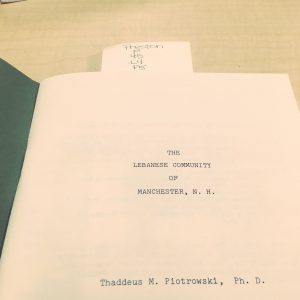 Patrick Driscoll, my partner in this COPLAC course, and I visited the Keene State College Archives to begin our research on migration history in New Hampshire. It was not the first time we had been here together and our previous experience conducting archival work certainly contributed to the ease of use we had in the facility this time around. We were able to quickly find, not without the help of our lovely archivists, several records of migration populations in New Hampshire. What we discovered were books. Most of these books come from a collection written by Thaddeus M. Piotrowski who spent what seems to be many years compiling information about various immigrant populations existing in New Hampshire, and specifically in the Manchester area, throughout history. Piotrowski produced individual books about each migrant group, went into detail about their histories, cultures, successes and setbacks living in the region, and much more. The groups were: Hispanics in New Hampshire, mostly lured here by an industrialized Granite State’s mills and textiles; Scots and their descendants in Londonderry New Hampshire; German-American groups and their heritage in New Hampshire; Vietnamese refugees of New Hampshire; the Finnish in Newport, New Hampshire, and the Lebanese population in New Hampshire.
Patrick Driscoll, my partner in this COPLAC course, and I visited the Keene State College Archives to begin our research on migration history in New Hampshire. It was not the first time we had been here together and our previous experience conducting archival work certainly contributed to the ease of use we had in the facility this time around. We were able to quickly find, not without the help of our lovely archivists, several records of migration populations in New Hampshire. What we discovered were books. Most of these books come from a collection written by Thaddeus M. Piotrowski who spent what seems to be many years compiling information about various immigrant populations existing in New Hampshire, and specifically in the Manchester area, throughout history. Piotrowski produced individual books about each migrant group, went into detail about their histories, cultures, successes and setbacks living in the region, and much more. The groups were: Hispanics in New Hampshire, mostly lured here by an industrialized Granite State’s mills and textiles; Scots and their descendants in Londonderry New Hampshire; German-American groups and their heritage in New Hampshire; Vietnamese refugees of New Hampshire; the Finnish in Newport, New Hampshire, and the Lebanese population in New Hampshire.
The archivist on duty even informed Patrick and I that in her experience growing up near Keene the French-Canadians were the largest group of immigrants who traveled here to work in the many mills in the state. When she would use her telephone as a girl she would even hear French language being spoken through the party lines.
Patrick and I took notes about all of these groups and will gladly revisit them to improve our research, but there is one group in particular that sparked our interest in terms of where to focus our project. This was the Lebanese immigrant population in New Hampshire. We are compelled to reveal more information about the Lebanese migration history in the area because of one bi t of information that set them apart from most immigrant populations who traveled into the Northeast. The majority of immigrant populations traveled here to work in mills and factories, but the Lebanese, according to our research, came to America and established small businesses. Not only was this unique but it was also surprising because we assumed that even if a group did not initially travel here to work in the mills, it would likely be difficult to state a small business because of a strained social status. Thus Patrick and I are fascinated by this community who we had little knowledge even impacted New Hampshire and we would love to bring more awareness to this culture for the betterment of ourselves as well as our community.
t of information that set them apart from most immigrant populations who traveled into the Northeast. The majority of immigrant populations traveled here to work in mills and factories, but the Lebanese, according to our research, came to America and established small businesses. Not only was this unique but it was also surprising because we assumed that even if a group did not initially travel here to work in the mills, it would likely be difficult to state a small business because of a strained social status. Thus Patrick and I are fascinated by this community who we had little knowledge even impacted New Hampshire and we would love to bring more awareness to this culture for the betterment of ourselves as well as our community.
